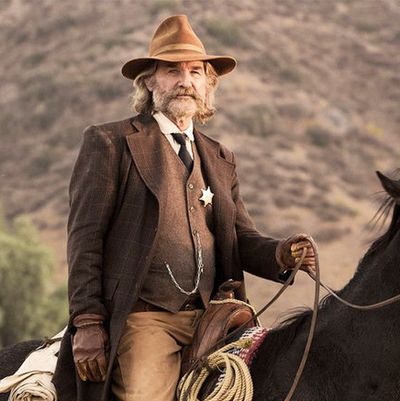
A tense, absorbing pursuit Western that turns into a Grand Guignol gorefest, Bone Tomahawk is what you might get if you crossbred The Searchers with The Texas Chain Saw Massacre, or maybe Cannibal Holocaust. It’s certainly not the first of its kind — we’ve had cannibal Westerns before, and we’ve had Western genre conventions pulled out from under us before — but it has a real respect for its characters, which makes all the difference.
In fact, aside from an opening sequence that involves a ghastly throat-slicing and a hideous, demon-like figure seen from a distance, the film initially feels like a fairly traditional Western. We spend the first act hanging out, Rio Grande–style, in a small settlement — I hesitate to call it a town — where most of the men have departed on a cattle drive. Left behind are Arthur O’Dwyer (Patrick Wilson), a ranch foreman stuck at home with his wife (Lili Simmons) thanks to a fractured tibia; John Brooder (Matthew Fox), a slick, dandyish gentleman with a past; Sheriff Franklin Hunt (Kurt Russell), and a couple of vaguely hapless deputies — the too-green Nick (Evan Jonigkeit) and the too-old Chicory (Richard Jenkins).
That doesn’t leave a lot of able-bodied men to choose from when several townspeople are killed and abducted by … well, “Troglodytes,” as one local Indian (Zach McClarnon) describes them, “a spoiled bloodline of inbred animals who rape and eat their own mothers.” As the Sheriff, Chicory, Brooder, and a crippled O’Dwyer head out on a journey to retrieve the captives, we know that they’ll eventually find real monsters out there. And most films would be content to play with that irony, to wink at us while setting up these complacent cowboys for their rendezvous with the unthinkable.
But writer-director S. Craig Zahler (and, full disclosure here: I know the guy, and consider him a friend, though I haven’t seen him in years) seems genuinely interested in watching these men play off one another. The daffy Chicory can’t stop talking and asking questions. Brooder is calculating and resourceful, but also paranoid and racist. O’Dwyer is desperate and pained, with his leg getting worse. And Sheriff Hunt is tormented by the role he himself might have played in allowing his people to get captured. Some might call the back-and-forth between these men Tarantino — a few conversations seem random, maybe even slightly anachronistic — but the interactions always reveal character, and their relationships develop in interesting ways. It also hints at a broader notion — that there is something rotten in these men’s own fear of others that has given birth to their predicament. By the time Bone Tomahawk rolls into its gruesome (and I mean gruesome) third act, we’re fully involved in these men and their little dramas, which just adds to the unnerving tension.
There’s an elegance to Bone Tomahawk that doesn’t let up even when it veers into cult-movie territory. Zahler is a patient director, willing to let scenes unfold, with tension developing organically. He uses music sparingly; the early scenes in town are almost unnaturally quiet, with the moody, minimalist score (credited to Jeff Herriot and Zahler himself) only kicking in once the search party strikes out for the territory. As the men become more and more desperate, the camera comes in closer and closer. But even the final act is devoid of the kind of unhinged stylistic hysteria that can take over films that upend genre. You could even say that’s what makes it so disturbing — the director’s unflinching eye reveals both character and violence. Bone Tomahawk is terrifying and strange, to be sure, but it’s the old-fashioned veneer that makes it beautiful.


